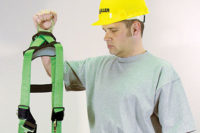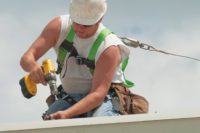Safeguard your employees
Using personal fall arrest systems require serious planning, training

Falling to a lower level may be a hazard employees are exposed to during their shift. However, taking the right precautions can keep employees who work four or more feet above a lower level from suffering injury or even death. OSHA has specific regulations that address these precautions for fall protection in general industry facilities at 29 CFR 1910.28 and 1910.140.
When to use
To illustrate the severity of falls in the workplace, the Bureau of Labor Statistics reported that in 2018 there were 615 fatalities from falls to a lower level.
In general industry, fall protection typically takes the form of guardrails. There may be times, however, when guardrails aren’t present. In that case, other types of fall protection, including personal fall arrest systems (PFAS), are needed. (Safety net systems are the third, and least common, type of fall protection.)
PFAS would be used when employees:
- Need to climb on top of equipment (without guardrails) to do an inspection, perform maintenance, or replace a defective part.
- Must work off a step ladder on something that is above a guardrail (such as a ventilation or heating unit) and falling from the ladder could cause the employee to fall over the guardrail.
- Operate powered industrial trucks with employee platforms (order pickers).
Planning
Before beginning any work that requires the use of a PFAS, a suitable anchorage point must be identified. OSHA requires the anchorage point be capable of supporting at least 5,000 pounds for each employee attached. These may be dedicated anchor points that were installed when the facility was built or thereafter. The anchor point could also be a piece of equipment that has a suitable attachment point that meets the 5,000-pound requirement.
Selection
Selecting the right PFAS that’s appropriate for the task and work situation is an important safety measure. Some PFAS are designed for specific work applications, such as:
- Climbing ladders and poles,
- Maintaining and servicing equipment, and
- Cleaning windows cleaning.
Inspecting the work environment is also important since acids, dirt, moisture, oil, grease, or other substances can have devastating effects on the system selected. Hot or cold environments must also be taken into consideration, and the PFAS components must be protected and inspected as necessary. Implement a program for regularly cleaning and maintaining the system.
OSHA requires that employers provide a means for promptly rescuing an employee if a fall occurs. Employers must determine the availability of rescue personnel, ladders, or other equipment since there may be instances in which employees can’t self-rescue. This must be factored in when selecting the proper PFAS.
System performance
Before purchasing a PFAS, the employer should get the information about its test performance (using recognized test methods) from the manufacturer. This will provide proof that the system meets the criteria in 29 CFR 1910.140.
Component compatibility
Manufacturers typically design, test, and supply a PFAS as a complete system. Problems may arise later when certain components wear out and employers need to replace them. However, it’s important to understand that not all components are interchangeable.
For example, a lanyard must never be connected between a body harness and a self-retracting deceleration device since this can result in additional free fall. A competent person must evaluate any component substitution or change to a PFAS to determine if it meets applicable OSHA standards before the system is used.
Free fall
Be aware that a system’s maximum arresting force is evaluated under normal use conditions established by the manufacturer. A PFAS must be set up so that an employee can’t free fall more than six feet. Allowing a free fall of more than six feet can significantly increase the arresting force on the employee, potentially causing injury and even exceeding the strength of the system.
PFAS must be worn with the attachment point of the body harness located in the center of the employee’s back near shoulder level. The tie-off attachment point to the lifeline or anchor must be located at or above the connection point of the harness (for example, above the employee’s head). If this isn’t done, additional free fall distance is added to fall.
Training
Make sure all employees are properly trained on the ins and outs of a PFAS before they’re allowed to use it. Training should include the following:
- Limits of the PFAS;
- Proper anchoring and tie-off techniques;
- Estimating free fall distance, including determining elongation and deceleration distance;
- Conditions at the worksite that may impact the use of the PFAS;
- Methods of use; and
- Inspection and storage.
Inspection
Inspect a PFAS before initial use during each work shift. Immediately remove from service a component with any of the following:
- Damage such as a cut, tear, abrasion, mold, or evidence of undue stretching;
- An alteration or addition that might impact its effectiveness;
- Damage due to deterioration, fire, acid, or other corrosive substances;
- Distorted hooks or faulty hook springs;
- Tongues that are unfitted to the shoulder of buckles;
- Loose or damaged mountings;
- Non-functioning parts;
- Wear and tear; and
- Internal deterioration.
When removing the component from service, it’s critical that it be tagged or marked as unusable, or it be destroyed.
In addition, any PFAS, including components, that are subjected to impact loading (which can occur during a fall) must be removed from service immediately, and not be used again until a competent person inspects the system and determines that:
- It’s not damaged, and
- It’s safe to use for personal fall protection.
Takeaways
Employers and employees alike must take fall protection seriously — especially the use of PFAS in the workplace. Planning, selection, training, and inspection play an important part in safeguarding employees when they use a PFAS.
Looking for a reprint of this article?
From high-res PDFs to custom plaques, order your copy today!





